Design of an Intelligent MEMS Safety and Arming Device with a Condition Feedback Function
Abstract
1. Introduction
2. Modeling
2.1. Structure of the Ignition Device
2.2. Structure of the S&A Device
2.3. Driving Principle of the S&A Device
3. Fabrication
4. Tests and Discussion
4.1. Test of the Bistable Function
4.2. Test of the Feedback Function
4.3. Test of the Safety and Arming Functions
5. Conclusions
Author Contributions
Funding
Conflicts of Interest
References
- Li, M.; Hu, T. Research status and development trend of MEMS S&A devices: A review. Def. Technol. 2021, 17, 450–456. [Google Scholar]
- Rehan, M.; Mansoor, M. Application of MEMS in safety and arming devices: An overview. Microsyst. Technol. 2021, 27, 3599–3610. [Google Scholar] [CrossRef]
- Robinson, C.H.; Wood, R.H.; Hoang, T.Q. Miniature MEMS-Based Electromechanical Safety and Arming Device. U.S. Patent 6,964,231, 15 November 2005. [Google Scholar]
- Seok, J.O.; Jeong, J.H.; Eom, J.; Lee, S.S.; Lee, C.J.; Ryu, S.M.; Oh, J.S. Ball driven type MEMS SAD for artillery fuse. J. Micromech. Microeng. 2017, 27, 015032. [Google Scholar] [CrossRef]
- Jeong, J.H.; Eom, J.; Lee, S.S.; Lim, D.W.; Jang, Y.I.; Seo, K.W.; Choi, S.S.; Lee, C.J.; Oh, J.S. Miniature mechanical safety and arming device with runaway escapement arming delay mechanism for artillery fuze. Sens. Actuator A Phys. 2018, 279, 518–524. [Google Scholar] [CrossRef]
- Tu, H.; Lou, W.; Sun, Z.; Qian, Y. Structural reliability simulation for the latching mechanism in MEMS-based safety and arming device. Adv. Eng. Softw. 2017, 108, 48–56. [Google Scholar] [CrossRef]
- Wang, D.; Lou, W.; Feng, Y.; Zhang, X. Design of high-reliability micro safety and arming devices for a small caliber projectile. Micromachines 2017, 8, 234. [Google Scholar] [CrossRef] [PubMed]
- Lei, S.; Cao, Y.; Nie, W.; Xi, Z.; Yao, J.; Zhu, H.; Lu, H. Research on mechanical responses of a novel inertially driven MEMS safety and arming device under dual-environment inertial loads. IEEE Sens. J. 2022, 22, 7645–7655. [Google Scholar] [CrossRef]
- Hu, T.; Fang, K.; Zhang, Z.; Jiang, X.; Zhao, Y. The research on MEMS SA device with metal-silicon composite structure. J. Microelectromech. Syst. 2019, 28, 1088–1099. [Google Scholar] [CrossRef]
- Hu, T.; Zhao, Y.; Li, X.; Zhao, Y.; Bai, Y. Integration design of MEMS electro-thermal safety-and-arming devices. Microsyst. Technol. 2017, 23, 953–958. [Google Scholar] [CrossRef]
- Maurer, W.H.; Soto, G.H.; Hollingsworth, D.R. Method for Utilizing a MEMS Safe Arm Device for Microdetonation. U.S. Patent 7,007,606, 7 March 2006. [Google Scholar]
- Maurer, W.H.; Soto, G.H.; Hollingsworth, D.R. MEMS Safe Arm Device for Microdetonation. U.S. Patent 7,040,234, 9 May 2006. [Google Scholar]
- Sun, Y.; Lou, W.; Feng, H.; Zhao, Y. Study on characteristics of electromagnetic coil used in MEMS safety and arming device. Micromachines 2020, 11, 749. [Google Scholar] [CrossRef] [PubMed]
- Wang, K.; Hu, T.; Zhao, Y.; Ren, W.; Liu, J. Design of a double-layer electrothermal MEMS safety and arming device with a bistable mechanism. Micromachines 2022, 13, 1076. [Google Scholar] [CrossRef] [PubMed]
- Wang, K.; Hu, T.; Zhao, Y.; Wen, R.; Liu, J. Design of a MEMS ignition device with a double-layer barrier electro-thermal safety and arming device. Chin. J. Energetic Mater. 2023, 31, 229–234. (In Chinese) [Google Scholar] [CrossRef]
- Wang, K.; Hu, T.; Zhao, Y.; Ren, W. Research on a MEMS pyrotechnic with a double-layer barrier safety and arming device. Def. Technol. 2022, 18, 2034–2044. [Google Scholar] [CrossRef]
- Liu, W.; Su, Q.; Xue, Y.; Xie, R.Z.; Ren, X.M.; Liu, L. Design and performance of NiCr-based micro-heater with lower excitation energy. In Journal of Physics: Conference Series; IOP Publishing: Bristol, UK, 2020; Volume 1507, p. 022015-23. [Google Scholar]
- Ahn, J.Y.; Kim, S.B.; Kim, J.H.; Jang, N.S.; Kim, D.H.; Lee, H.W.; Kim, J.M.; Kim, S.H. A micro-chip initiator with controlled combustion reactivity realized by integrating Al/CuO nanothermite composites on a microhotplate platform. J. Micromech. Microeng. 2016, 26, 015002. [Google Scholar] [CrossRef]
- Yang, T.; Shen, Y.; Dai, J.; Guo-Qiang, Z.; Cheng-Ai, W.; Ying-Hua, Y.; Rui-Qi, S. Fabrication and characterization of a Ni-Cr@Al/CuO insensitive energetic element. Chin. J. Energetic Mater. 2019, 27, 830–836. (In Chinese) [Google Scholar]
- Dai, J.; Wang, C.G.; Wang, Y.T.; Xu, W.; Xu, J.; Shen, Y.; Zhang, W.; Ye, Y.; Shen, R. From nanoparticles to on-chip 3D nanothermite: Electrospray deposition of reactive Al/CuO@NC onto semiconductor bridge and its application for rapid ignition. Nanotechnology 2020, 31, 195712. [Google Scholar] [CrossRef] [PubMed]
- Xu, J.; Chen, Y.; Zhang, W.; Zheng, Z.; Yu, C.; Wang, J.; Song, C.; Chen, J.; Lei, X.; Ma, K. Direct ink writing of nAl/pCuO/HPMC with outstanding combustion performance and ignition performance. Combust. Flame 2022, 236, 111747. [Google Scholar] [CrossRef]
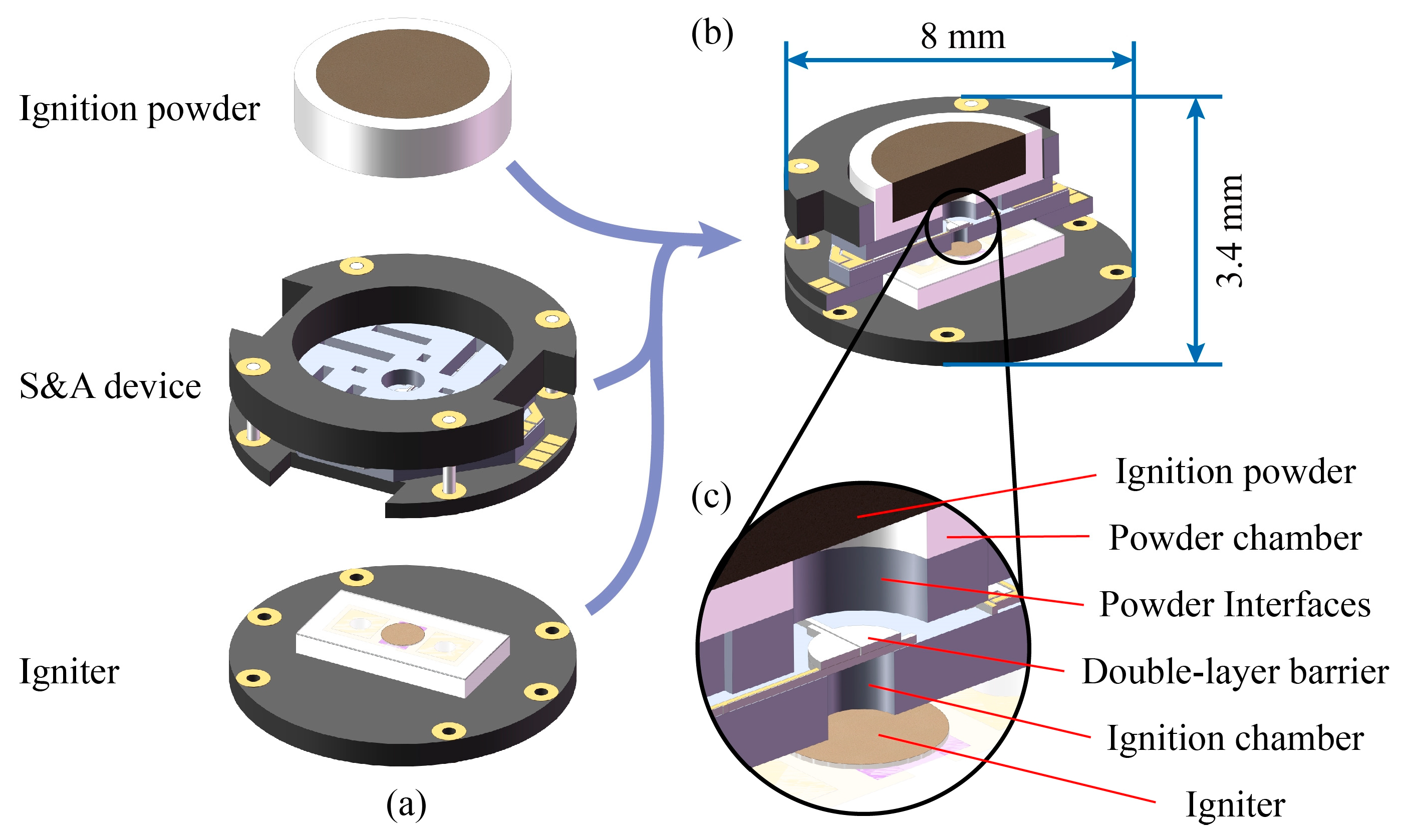
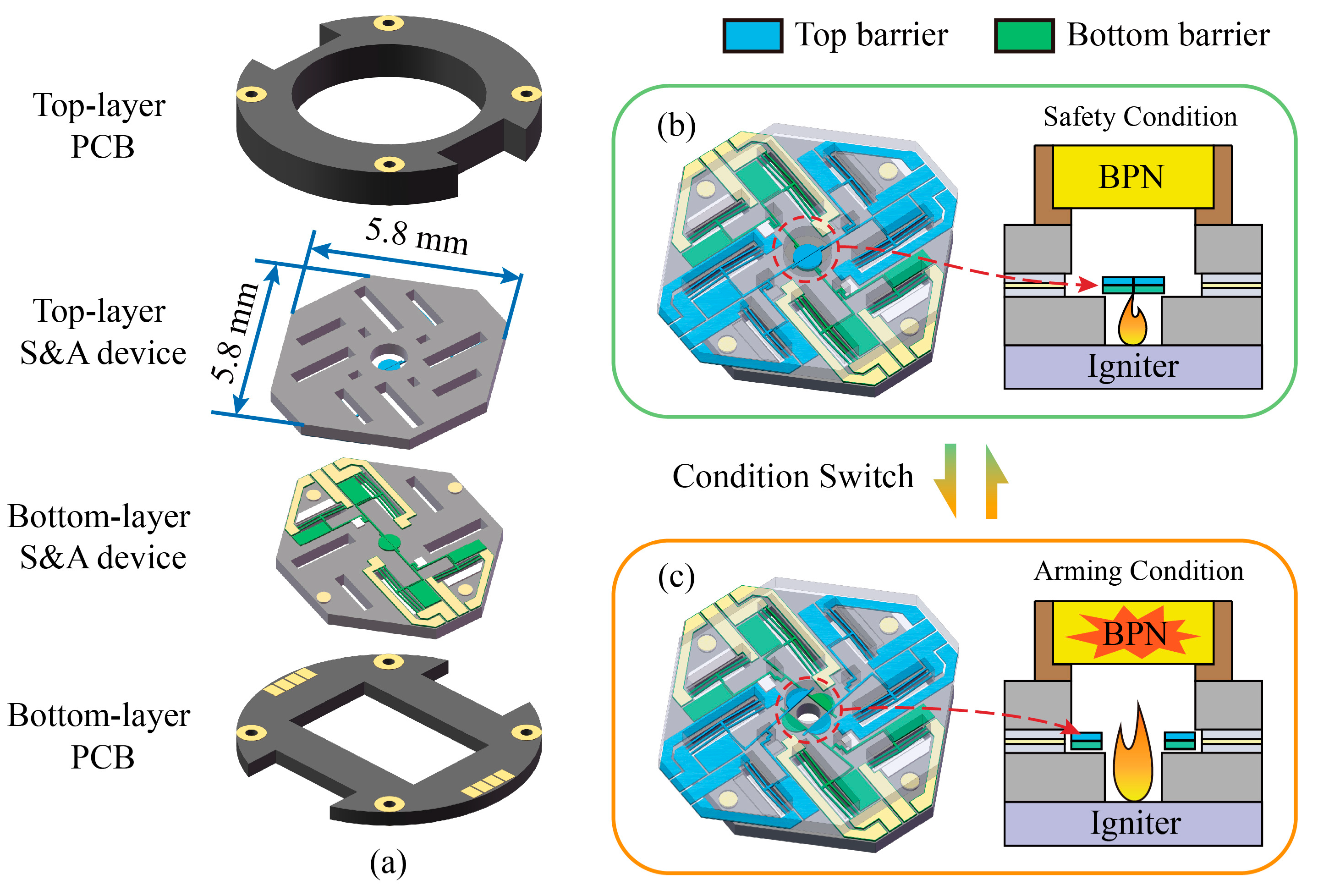
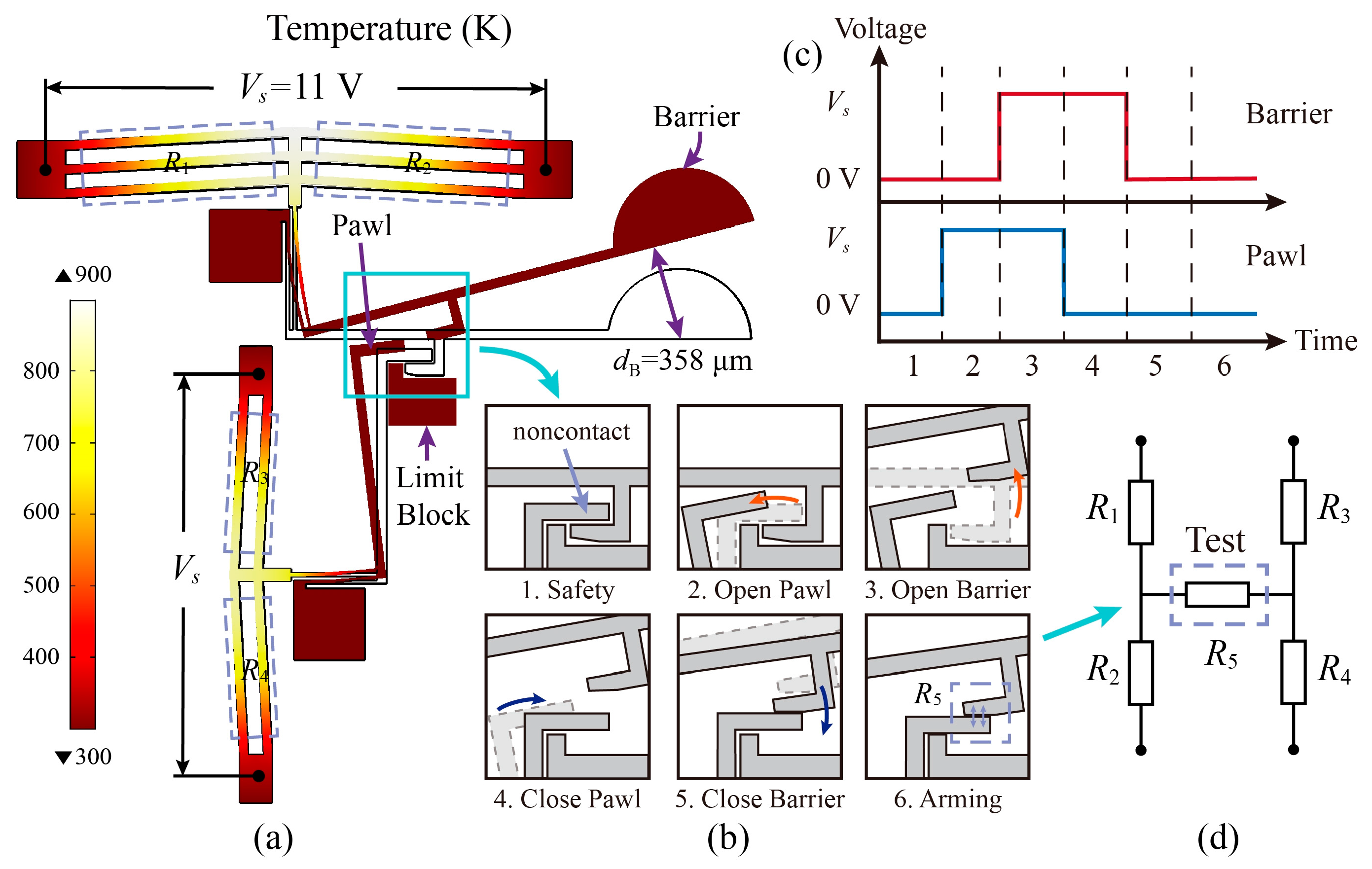
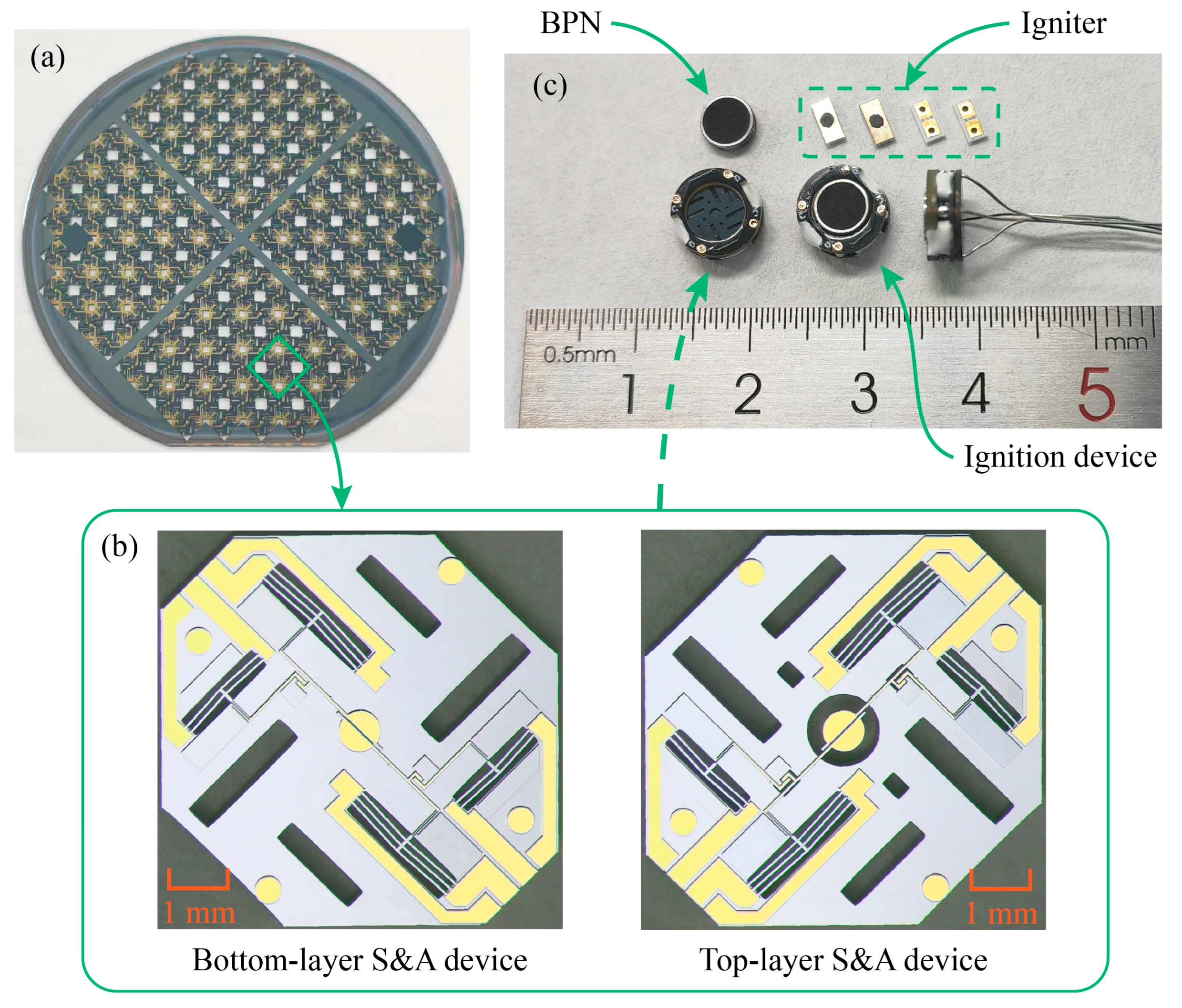
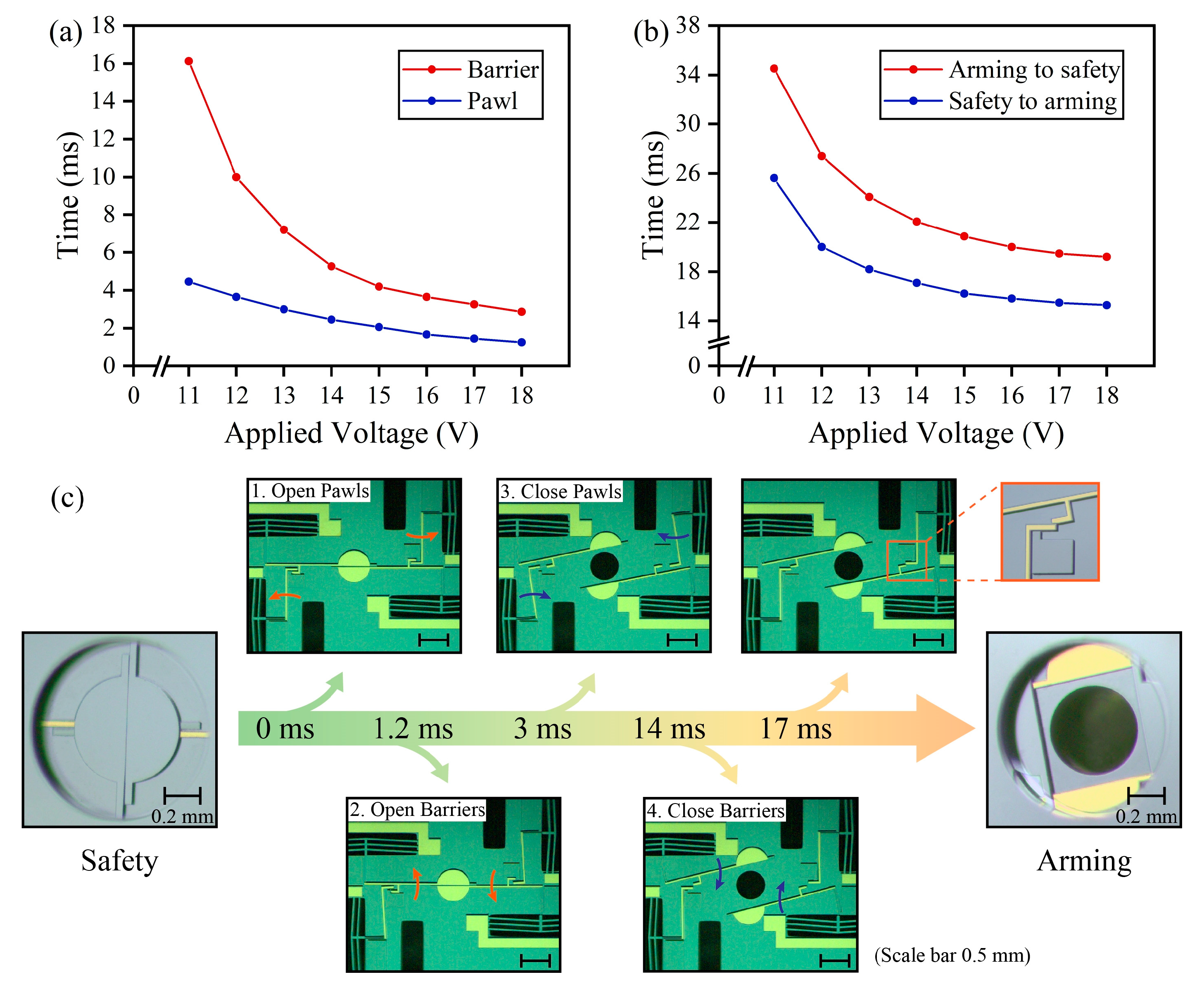
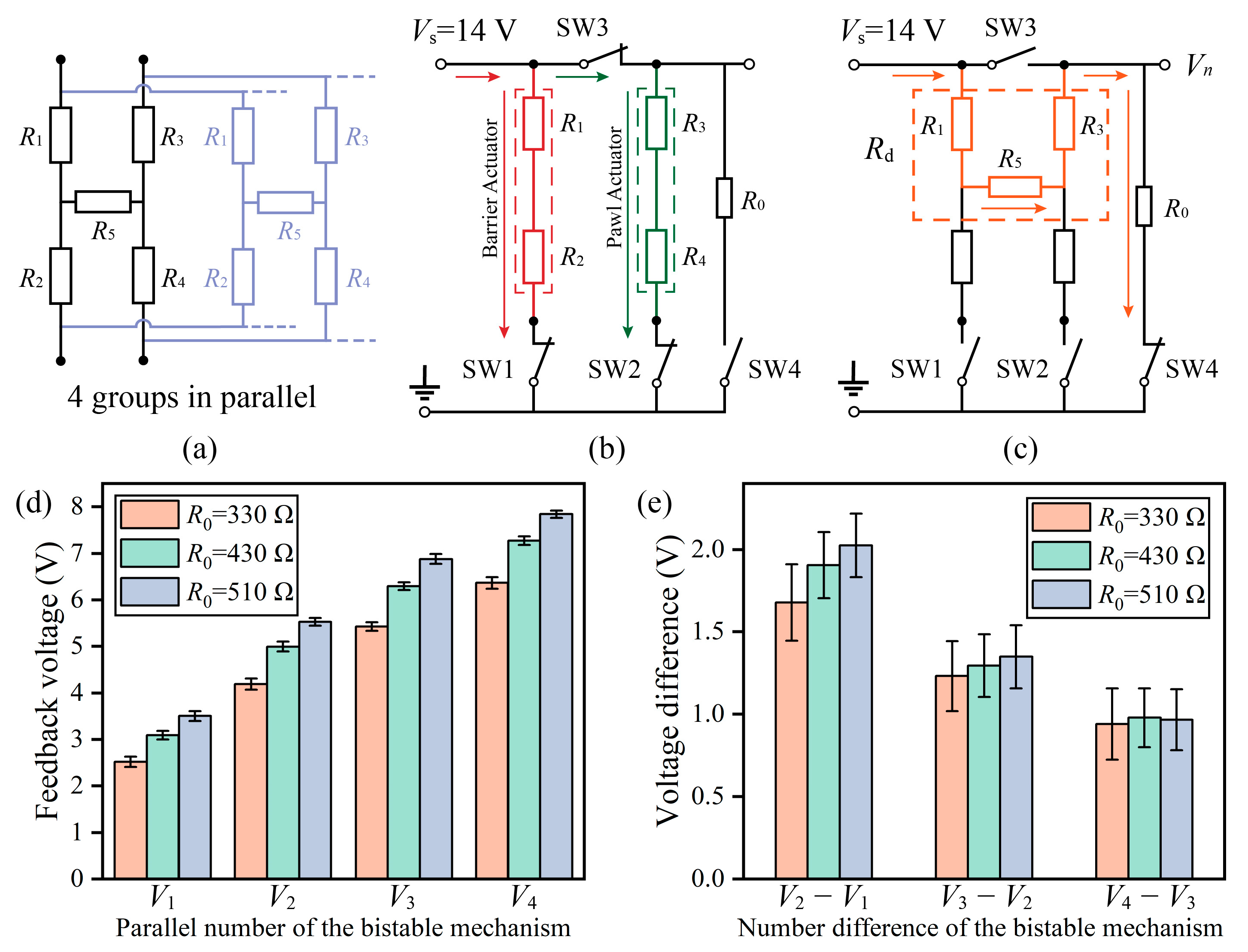
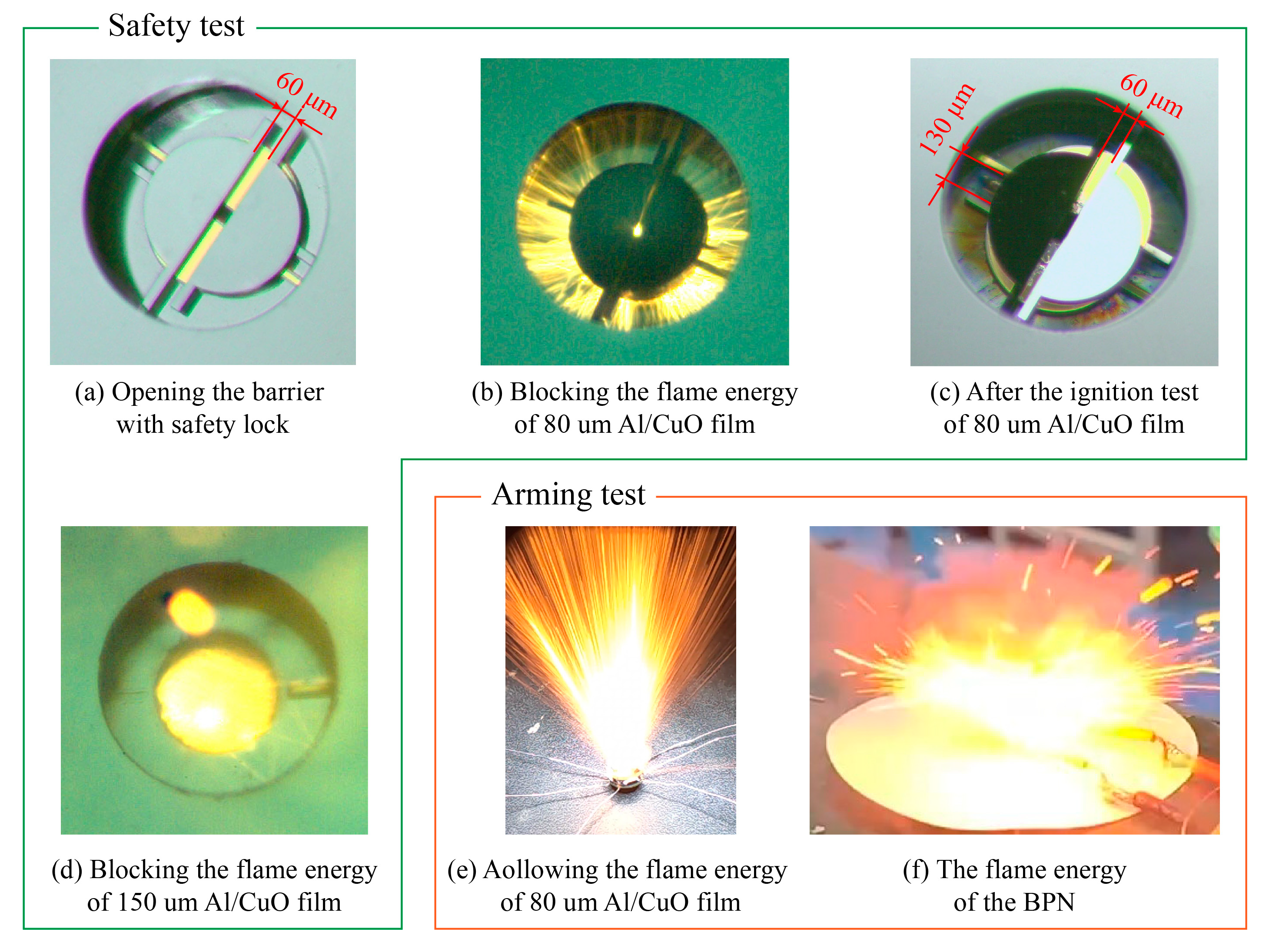
| Item | Barrier Actuator | Pawl Actuator | Unit |
|---|---|---|---|
| Width (w) | 35 | 35 | μm |
| Length (L) | 1900 | 1500 | μm |
| Thickness (h) | 50 | 50 | μm |
| Angle (θ) | 3 | 3 | ° |
| Number of beams | 3 | 2 | None |
| Width of the soft lever (w′) | 14 | 14 | μm |
| Length of the soft lever (L′) | 500 | 350 | μm |
| Distance of the soft beams (Ld) | 30 | 30 | μm |
| Enlarged proportion | 55 | 33 | None |
| Thickness of Al/CuO Film | Charge Quantity of Al/CuO Film | Ignition Test in Safety Condition | Charge Quantity of Al/CuO Film | Ignition Test in Arming Condition |
|---|---|---|---|---|
| 80 μm | 0.47 mg | Safety | 0.42 mg | Ignition |
| 0.42 mg | Safety | 0.41 mg | Ignition | |
| 0.43 mg | Safety | / | / | |
| 0.42 mg | Safety | / | / | |
| 100 μm | 0.52 mg | Safety | 0.50 mg | Ignition |
| 0.51 mg | Safety | 0.53 mg | Ignition | |
| 0.51 mg | Safety | / | / | |
| 0.54 mg | Safety | / | / | |
| 150 μm | 0.74 mg | Ignition | 0.74 mg | Ignition |
| 0.76 mg | Ignition | 0.76 mg | Ignition | |
| 0.73 mg | Ignition | / | / | |
| 0.74 mg | Ignition | / | / |
Disclaimer/Publisher’s Note: The statements, opinions and data contained in all publications are solely those of the individual author(s) and contributor(s) and not of MDPI and/or the editor(s). MDPI and/or the editor(s) disclaim responsibility for any injury to people or property resulting from any ideas, methods, instructions or products referred to in the content. |
© 2023 by the authors. Licensee MDPI, Basel, Switzerland. This article is an open access article distributed under the terms and conditions of the Creative Commons Attribution (CC BY) license (https://creativecommons.org/licenses/by/4.0/).
Share and Cite
Wang, K.; Hu, T.; Zhao, Y.; Ren, W.; Wang, Y. Design of an Intelligent MEMS Safety and Arming Device with a Condition Feedback Function. Micromachines 2023, 14, 1130. https://doi.org/10.3390/mi14061130
Wang K, Hu T, Zhao Y, Ren W, Wang Y. Design of an Intelligent MEMS Safety and Arming Device with a Condition Feedback Function. Micromachines. 2023; 14(6):1130. https://doi.org/10.3390/mi14061130
Chicago/Turabian StyleWang, Kexin, Tengjiang Hu, Yulong Zhao, Wei Ren, and Yifei Wang. 2023. "Design of an Intelligent MEMS Safety and Arming Device with a Condition Feedback Function" Micromachines 14, no. 6: 1130. https://doi.org/10.3390/mi14061130
APA StyleWang, K., Hu, T., Zhao, Y., Ren, W., & Wang, Y. (2023). Design of an Intelligent MEMS Safety and Arming Device with a Condition Feedback Function. Micromachines, 14(6), 1130. https://doi.org/10.3390/mi14061130







